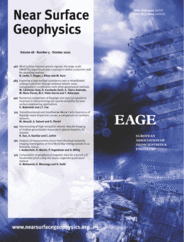
Full text loading...
 , David Escobedo‐Zenil1, Andrés Tejero‐Andrade1, Muricio Nava‐Flores1
, David Escobedo‐Zenil1, Andrés Tejero‐Andrade1, Muricio Nava‐Flores1 , Martín Carlos Vidal‐García1
, Martín Carlos Vidal‐García1 , Thulasiraman Natarajan2
, Thulasiraman Natarajan2
An unexpected surface subsidence in Mexico City on 19 May 2015 prompted a detailed geophysical investigation of the three‐dimensional structure of a collapsed‐soil mine located in a section of the Chapultepec Park in the vicinity of an artificial lake. As revealed from past geological explorations, the subsoil at the site consists of volcano‐sedimentary materials that were quarried in the mid‐20th century; subsequently, during the construction of the park, most of those mines had been only partially rehabilitated, with a potential risk of land subsidence. Near‐surface imaging techniques based on ambient seismic noise as well as microgravimetry, electrical resistivity tomography, shallow seismic refraction methods were evaluated for their applicability to characterize the structure of the collapsed mine. Tomography images computed using ambient‐noise array data characterized the extent of the underground mine showing high‐velocity anomaly, while results from microgravimetry and electrical resistivity tomography analyses indicated the structure through weak contrasts in gravity and resistivity anomalies. Additionally, electrical resistivity tomography results also illustrated the saturated nature of the subsoil. While different methods exhibit different capabilities to constrain such a small spatial feature, the present study highlighted the scope of an integrated approach in confirming the existence of potential voids as well as to estimate soil‐subsidence hazard. In terms of operational convenience and rapid performance, the ambient noise tomography method proved to be a relatively efficient and economical reconnaissance tool for identifying 3D velocity contrasts in an urban environment.

Article metrics loading...

Full text loading...
References


Data & Media loading...

